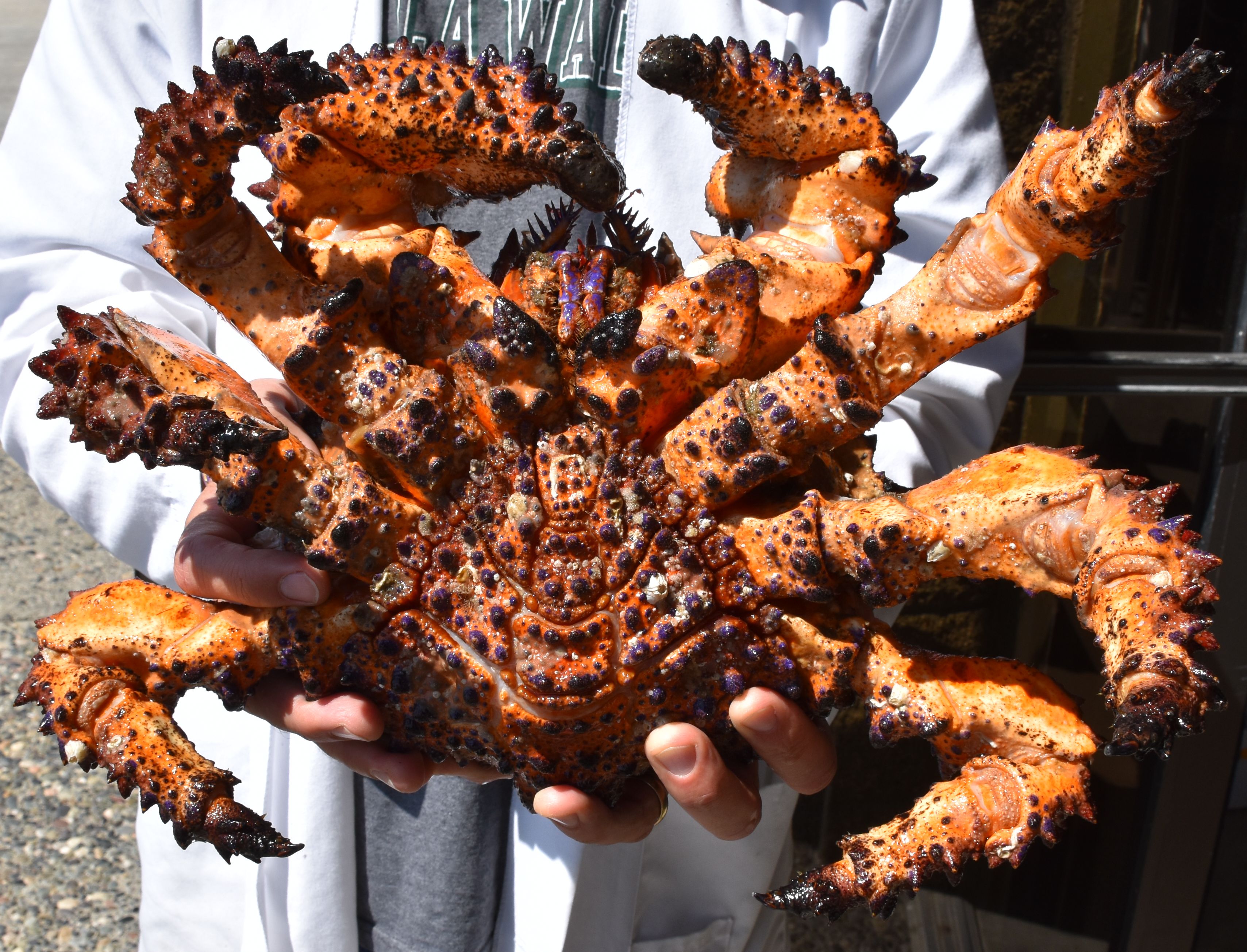Lopholithodes mandtii (Brandt, 1849)Common name(s): Puget Sound King Crab |
|
| Synonyms: Echinocerus cibarius, Ctenorhinus setimanus |  |
| Phylum Arthropoda
Subphylum Crustacea Class Malacostraca Subclass Eucarida Order Decapoda Suborder Pleocyemata Infraorder Anomura Family Lithodidae |
|
| Lopholithodes mandtii, about 15 cm across carapace. Caught by SCUBA off Sares Head | |
| Photo by Dave Cowles | |
How to Distinguish from Similar Species: The most similar species is Lopholithodes foraminatus, the box crab. L. foraminatus has a large sinus excavated from the carpus of the cheliped so that when viewed from the front it has an obvious "breathing hole" through the chelipeds, while this species does not (picture). L. foraminatus also has spinelike tubercles on the legs and chelipeds instead of blunt, rounded spines as seen on L. mandtii. The color of the two crabs is also distinctive.
Geographical Range: Sitka, Alaska to Monterey, CA
Depth Range: Subtidal to 137 m
Habitat: In rocky areas, especially areas with strong currents. We find it occasionally by SCUBA along Sares Head.
Biology/Natural
History: Note: DO NOT COLLECT
THIS CRAB! It is uncommon in Puget
Sound/Straits and the
Washington Fish and Wildlife dept. lists it as a protected
species.
Adults come up shallower to breed in late winter and spring.
This
is one of the largest crabs on the Pacific Coast of the 48
states.
Carapace
width can be up to 30 cm or more. It feeds on sea urchins and
other
echinoderms, has been observed eating sea anemones. Chelae
are surprisingly cuplike, and lined with teeth and setae
(picture). Juveniles
are a bright orange with
prominent tubercles
on the carapace,
and may occasionally be found under rocks at extremely low tide.
| Return to: | |||
| Main Page | Alphabetic Index | Systematic Index | Glossary |
References:
Dichotomous Keys:
Coffin, 1952Flora and Fairbanks, 1966
Hart, 1982
Kozloff, 1987
Wicksten, 2009
General References:
Jensen,
1995
Scientific Articles:
General Notes and Observations: Locations, abundances, unusual behaviors, etc.: We find this species from time to time on Sares Head.

Its chelae have teeth and setae along the edges but a cuplike depression in the surface. Photo by Dave Cowles

Note that the antennae have spines. (Note also that this animal is encrusted with barnacles). Photo by Dave Cowles

When this species folds its legs together, which it often does in defense, they fit tightly against the carapace and against each other. Photo by Dave Cowles

Note that the carpus of the chelae does not have a large, obvious sinus that serves as a "breathing hole" when the legs are folded tight against the carapace. Photo by Dave Cowles
There is a very large preserved individual of this species, captured many years ago, on display at the main Walla Walla College campus in the Biology department. Its carapace width is 22 cm. All the color has faded to a flesh tone with a few slightly darker red spots. (Dave Cowles)
The three chela
photos below are of a specimen seen at 18 m depth on Sares Head, June
24,
2005. Carapace
width 18 cm. The left chela
has strong, molar-like dentitions, while the right chela
is narrower, spoon-shaped, and with narrow dentitions only along the
margin.
 |
 |
| The right chela (above) is narrower than the left, spoonlike, and has narrow dentitions along the margins. The left chela (right, dactyl and above right, propodus) has large, molar-like dentitions. It appears that the left chela is for crushing and the right is for finer handling and cutting. Note the many setae along the edges of both chelae. These photos are from a large individual, 18 cm carapace width. |  |
 |
 |
| This very small (juvenile) individual (top and side view above) has a carapace width of only 4.5 cm. Photo by Dave Cowles | |

An underwater photo of a juvenile by Kirt Onthank, August 2007
| A near-record size individual, captured in 2015. These animals should not normally be disturbed. This one was collected for exhibit by a group with a special collector's permit. Carapace width is 26 cm and carapace length is about 17 cm. I am guessing it is a female, though it can be hard to tell with Anomuran crabs such as this one. If you would like to see this beautiful animal up close, visit the Point Defiance Aquarium. | |
 |
 |
Authors and Editors of Page:
Dave Cowles (2004): Created original page